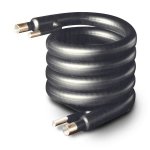budleydoright
Member
https://www.icmag.com/ic/picture.php?albumid=20521&pictureid=797405
Yes, it is a converted window shaker. Many commercial chillers use them as their base. In this case he simply cut the case down and painted it black. I know the connections to the chiller coil are a little fragile on this unit.
Shit, all this talk has me thinking about trying some of my old kit. I see 3-4 ton condensing units on craigslist all the time for $400. I could build a 4 ton chiller for under a grand.
Here's a good pic of the coaxial coil that can replace either the condensing or evaorative coil. refrigerant goes in the small tube.
With two of these you could make a water cooled chiller that produces both hot and cold water at the same time.
Hey Budly,
Is that a converted window unit?
It looks like it is. I found it on ebay(thanks for the search help), and it doesn't say. I really want the heat from my chiller to stay outside the house.
Thanks
Yes, it is a converted window shaker. Many commercial chillers use them as their base. In this case he simply cut the case down and painted it black. I know the connections to the chiller coil are a little fragile on this unit.
Shit, all this talk has me thinking about trying some of my old kit. I see 3-4 ton condensing units on craigslist all the time for $400. I could build a 4 ton chiller for under a grand.
Here's a good pic of the coaxial coil that can replace either the condensing or evaorative coil. refrigerant goes in the small tube.
With two of these you could make a water cooled chiller that produces both hot and cold water at the same time.




